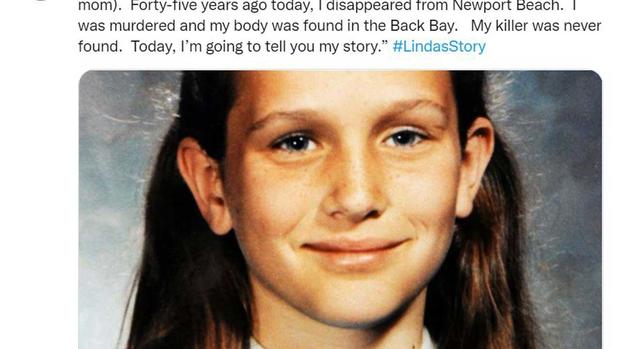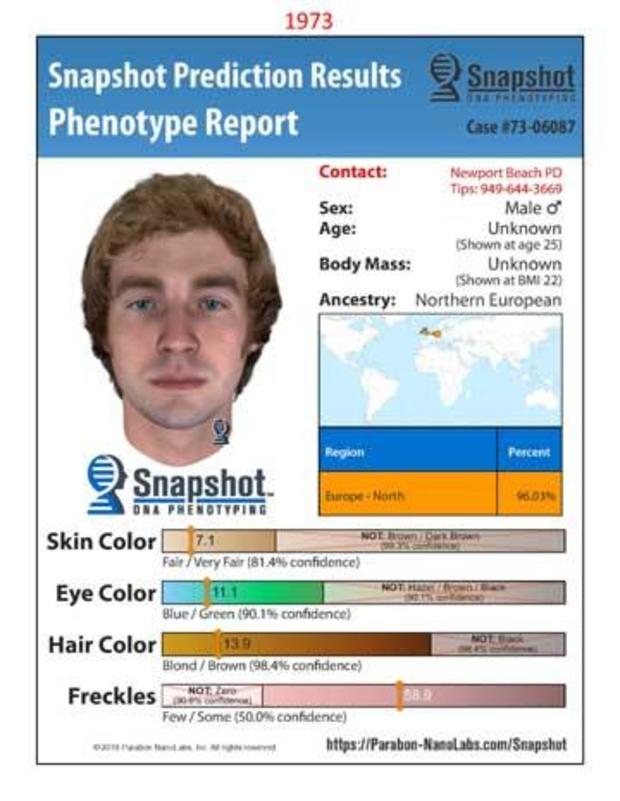#LindasStory: Police give child murder victim a voice on Twitter to help catch her killer
Making an 11-year-old murder victim the narrator of her own harrowing last moments of life and death is not a responsibility former Newport Beach Police spokesperson Jennifer Manzella took lightly. But when Sgt. Court Depweg tasked her with putting Linda O’Keefe’s face “on every phone, every iPad, every laptop in the country” to generate new leads on the 45-year-old cold case, she knew it was an opportunity to empower the young victim.
According to Depweg, “Right away, she said ‘What about Twitter?'”
“It was so important for me,” says Manzella, “to give this little girl whose life was cut short at 11 years old the opportunity to speak again.”
“48 Hours” and correspondent Tracy Smith take a look at the cold case and the quest to find Linda O’Keefe’s murderer in “#LindasStory,” airing Saturday, October 16 at 10/9c on CBS and Paramount+.
It was an unorthodox, if not risky, move for a police department to reveal details about an unsolved case from 1973. But Depweg said after 45 years, they had nothing to lose. The case had frustrated detectives for decades. Like generations of investigators, Manzella had been moved by a photo of Linda that had hung in the Newport Beach Police Department all those years, her serene smile and placid blue eyes a haunting reminder of justice denied her for so long. Manzella also felt a personal connection to Linda. “The photo that we have hanging up on the wall of our cold case area looks exactly like a photo of me when I was in grade school. I think she is such a knowable character.”
On July 6, 2018, exactly 45 years after Linda’s disappearance, the Newport Beach PD devoted its Twitter page to #LindasStory.
“Hi, I’m Linda O’Keefe (or Linda ANN O’Keefe, if I’m in trouble with my mom),” begins the first tweet. “Forty-five years ago today, I disappeared from Newport Beach. I was murdered and my body was found in the Back Bay. My killer was never found. Today, I’m going to tell you my story.”
The series of 68 tweets drew readers in with details about Linda’s life, as well as foreboding moments about her last day. Manzella had carefully crafted the narrative based on the police reports and an interview with Linda’s sister.
“At 8:00 am, I walk out my front door… and have no idea that it will be the last time,” reads another tweet.
In a later tweet, she writes, “Finally, school is over. Like everyone else in the classroom, I’m getting excited about how to spend the rest of my afternoon, or what I want to do this weekend. I obviously don’t know it yet but… I won’t get to have a weekend.”
“When a victim speaks, we want to listen,” Manzella says.
In fact, #LindasStory was seen, liked, and retweeted nearly 7 million times all over the world. “We were all over South America, in Europe … Australia, France,” Manzella said. “There wasn’t a corner of the world that wasn’t talking about it.”
The irony of Linda’s voice resonating around the world wasn’t lost on her schoolmates, who remembered her as “painfully shy.” For Jeff Thurnher, Brian Weaver, Lysa Christopher, David Wedemeyer and Terry Briscoe Corwin, #LindasStory transported them back in time to the summer of 1973, and the moment their innocence was shattered. “It was hard to imagine a girl my age could be killed,” recalls Corwin.
On July 6, 1973, Linda, who usually rode her bike to summer school in the sleepy beach town of Corona del Mar, had been given a ride to school. After school, not wanting to walk home, she had called her mom to pick her up. Her older sister Cindy, who overheard the conversation, remembers her mother telling Linda she was too busy with her work and that Linda should walk home. “Linda, just walk home, you’ll be fine,” Cindy recalls. “Of course, she didn’t come home.” She says that phone call would haunt her mother for the rest of her life.
Yet in that moment, Linda’s mother wasn’t very concerned. It wasn’t unusual for kids back then to stay out until the streetlights came on. But when she still wasn’t back by dinner, her parents called police. An exhaustive all-night search came up empty.
“Tons of people are looking for me. The helicopter has been scouring the canyons and remote areas of Corona del Mar,” reads another tweet.
#LindasStory captured the real-life uncertainty of the search, leaving readers on the edge of their seats. The tweets picked up again on the morning of July 7, when a local architect named Ron Yeo, who was on a bike ride with his 4-year-old son, discovered Linda’s body in a ditch along a nature trail known as the Back Bay. It was about 3 miles from the O’Keefe home.
“The man is looking in the ditch on the east side of Back Bay Drive, searching for frogs in the cattails. Instead, he sees something small, and pale. My hand. He sees my hand. He screams, trying to rouse me,” reads the tweet.
Linda was last seen alive on July 6, 1973 around 1:15 p.m., near an intersection on her way home from school. A mother and daughter who lived down the street from the O’Keefe family later told investigators they had spotted Linda talking to a man in a turquoise blue van.
“They see something they won’t forget for a long time,” reads the tweet. “It’s me. And a turquoise van.”
Linda’s classmates remember getting on their bikes and looking for the van. “If we could find the van,” says Lysa Christopher, “we were going to find the murderer.”
But neither the well-intentioned 11-year-olds nor the police had much to go on besides an incomplete description of a turquoise van and its driver. Sgt. Depweg says eventually investigators ran out of leads and the case went cold. Linda’s parents would die never knowing who killed their daughter.
Depweg explains that investigators at the time did what they could with what they had, adding that he’s not sure if the case was solvable then and that there were “a lot of unanswered questions.” When Depweg became sergeant of the violent crimes unit in September 2017, he was hopeful those questions could now be answered through advances in forensic science and technology.
Linda had been sexually assaulted — a detail that investigators kept close to the vest for decades. And even though DNA science didn’t exist in crime-solving in 1973, a forward-thinking criminalist named Jim White had swabbed semen left by the killer on Linda’s body, and preserved it. That DNA evidence sat in a freezer for decades, waiting for science to catch up.
After DNA testing on the case in the late 90s, the DNA profile had been entered into the national DNA database CODIS, but never yielded any matches. But by 2017, DNA had advanced by leaps and bounds. Depweg hired a company called Parabon Nanolabs to generate a “DNA snapshot” of the suspect based on his genetic characteristics.
Newport Beach Police Department/Parabon
Depweg says, “We now knew for sure that he was a Caucasian male” and that “we had some identifying attributes that we didn’t know before because all we had is a composite from 1973.” That DNA composite would be released to the public as the finale of #LindasStory.
The tweet reads: “There is a new lead in my case: a face. A face that comes from DNA that the killer left behind. It’s technology that didn’t exist back in 1973, but it might change everything today.”
Depweg says he first knew having DNA would be critical in the O’Keefe case when a jaw-dropping arrest in another old case was announced in April 2018. Joseph James D’Angelo, a former cop, was identified as the Golden State Killer nearly half a century after he first began terrorizing neighborhoods along the California coast.
The Golden State Killer arrest was also the catalyst for Linda’s classmates to try once again to help solve the case. Brian Weaver thought, “They got him by DNA … they gotta have something,” he said. “It’s Linda’s turn.” He posted on Facebook asking if anyone remembered Linda’s case, and he and the other friends joined forces. No longer helpless 11-year-olds searching for clues on their bikes, they quickly put up a Facebook page, “Justice for Linda Ann O’Keefe.” And they even went to Newport Beach Police Department, wanting to reopen the case. They had no idea Sgt. Depweg’s team of cold case investigators had already been working the case, or that Newport Beach PD would be releasing #LindasStory two months later.
Depweg says that in addition to helping them generate new leads, the Twitter campaign was part of his strategy to lay a trap for the killer. Confident the DNA would eventually lead to a suspect, Depweg says he knew it would be difficult to get a judge to sign off on a search warrant for cellphone and computer records on a case that predated digital technology. But #LindasStory would give them probable cause to argue that that the killer could be one of the millions of people reading the Twitter story and searching for new information about case.
When #LindasStory launched in July 2018, even Sgt. Depweg couldn’t have imagined how the investigation was about to unfold.
Download our Free App
For Breaking News & Analysis Download the Free CBS News app
[ad_2]
Share this news on your Fb,Twitter and Whatsapp
NY Press News:Latest News Headlines
NY Press News||Health||New York||USA News||Technology||World News

